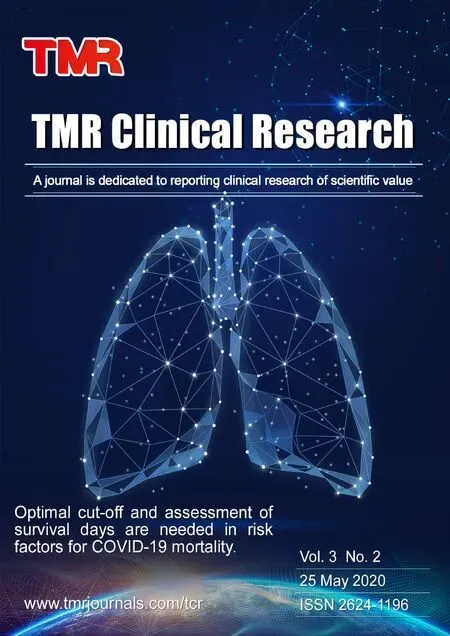Optimal cut-off and assessment of survival days are needed in risk factors for COVID-19 mortality
2020-12-12XiangLinHuKeLangMaoSenDouChaoMinWu
Xiang-Lin Hu ,Ke Lang ,Mao-Sen Dou ,Chao-Min Wu,2*
1Department of Pulmonary Medicine,Zhongshan Hospital,Fudan University,Shanghai 200032,China.2Department of Pulmonary Medicine,Qingpu Branch of Zhongshan Hospital Affiliated to Fudan University,Shanghai 201700,China.
We recently read the study published on The Lancet by Dr.Zhou and colleagues,entitled “Clinical course and risk factors for mortality of adult inpatients with COVID-19 in Wuhan,China:a retrospective cohort study”,with great interest[1].
First,we do not think this study was a cohort study but should be a case-control study.In their study,Dr.Zhou and colleagues compared the clinical characteristics between COVID-19 survivors and non-survivors.The primary outcome in this study was mortality.The authors obviously had defined two groups at the start based on the primary outcome:one with mortality and one without mortality.The authors looked back to evaluate if there was a statistical difference in clinical characteristics between the two groups.This study design clearly began with an outcome to comprehend the causes.Therefore,it should be a retrospective case-control study,rather than a retrospective cohort study as the authors stated in the article title,methods and even the full-text.In addition,the authors used odds ratio (OR) to measure the outcome.It needs to be pointed out that OR is applicable to case-control study while risk ratio is applicable to cohort study.
Second,we suggest an optimal cut-off could be provided for the significant continuous variables,such as age and D-dimer.The authors declared that age as an independent risk factor for mortality,with the adjusted OR of 1.10.OR of 1.10 means age older one year increases the risk of mortality by 10.0 percent.However,this was not straightaway or easily understood for general clinicians in the daily clinical practice.We suggest the authors could divide the continuous data of age into categorical data to enter the regression model.They could use receiver operating characteristic (ROC) curve to determine an optimal cut-off of age as the risk factor.Or they could use ten years interval,such as age <46 years,age from 46 to 56,age from 56 to 66 and etc.Both of the two methods can yield an easily understood and applicable OR of age.Only in this way can we general clinicians better use it to serve our daily clinical practice.
The authors declared that D-dimer greater than 1 μg/mL was an independent risk factor of mortality.We are wondering how the cut-off of 1 μg/mL was determined and whether it was optimal to discriminate mortality.The clinical normal range of D-dimer is from 0.0 to 1.5 μg/mL[2,3].In the authors'study,the median value of D-dimer was 0.8 (interquartile range 0.4-3.2) μg/mL.They divided D-dimer into three categories:≤0.5,>0.5 to ≤1 and >1 μg/mL.This categorical method was not based on the clinical normal cut-off or the median,nor was it based on ROC curve.Considering the authors wanted D-dimer >1 μg/mL could help clinicians to early identify COVID-19 patients with poor prognosis,an optimal cut-off of D-dimer needs to be determined using ROC curve.
Third,we suggest hospital survival days could be assessed in COVID-19 mortality.In survival analysis,we not only concern the event of mortality,but also concern the time-to-event.As the authors showed,the overall hospital survival days of the deceased patients were 7.5 (interquartile range 5.0-11.0) days.Some patients may rapidly progress to death while others may have a long survival until death.It is interesting to explore whether these risk factors (age,sequential organ failure assessment (SOFA) and D-dimer) had correlations with survival days.A preprint [4]published by our study group showed high-sensitivity cardiac troponin I had significantly negative correlation with survival days.This means the higher high-sensitivity cardiac troponin I was,the much earlier the patients would die.Therefore,whether higher age,SOFA and D-dimer,as the authors recommended,are associated with early mortality deserves further investigation,using Kaplan-Meier curve or correlation analysis.
Overall,we appreciate Dr.Zhou and colleagues'conclusion,which was yielded from a case-control study,that “the potential risk factors of older age,high SOFA score,and D-dimer greater than 1 μg/mL could help clinicians to identify patients with poor prognosis at an early stage”.However,in order to achieve this goal in the real clinical practice,we need categorical translation with optimal cut-off determined for these variables.In addition,survival days need to be considered in assessment of COVID-19 mortality in the future study.
杂志排行
Clinical Research Communications的其它文章
- Insight into the post-hospital syndrome
- Visual analysis of advance care planning related studies
- Traditional Chinese medicine treatment of immune-related pneumonia caused by PD-1/PD-L1 inhibitors
- Meta-analysis of the efficacy and safety of sodium fusidate ointment and mupirocin ointment in the treatment of bacteria-infected skin disease
- Research progress of acupuncture in the treatment of Parkinson's disease
